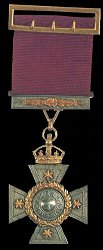
The New Zealand Cross was introduced in 1869 during the New Zealand Wars in New Zealand. The wars were fought between natives of New Zealand, the Māori, and forces raised by European settlers known as Pākehā assisted by British troops.
Many acts of bravery, gallantry and devotion to duty were recorded among the local militia, armed constabulary and volunteers, but there was one militia Victoria Cross awarded to Charles Heaphy in 1867 for action in 1864.
On 10 March 1869, without checking the facts and under the mistaken impression colonial troops were not eligible for the Victoria Cross unless under command of British troops, the Governor of New Zealand, Sir George Bowen, instituted the New Zealand Cross as the highest New Zealand award.
He was widely criticised in England, and accused of usurping the prerogative of Queen Victoria, but she eventually ratified his action.[1]
Only 23 New Zealand Crosses were awarded with first six published in the New Zealand Gazette in 1869. There was one award gazetted in 1870 and the remaining 16 awards gazetted between 1875 and 1910, from six to 44 years after the actions commended.[2]
It has the form of a silver cross pattée. The obverse contains the words 'NEW ZEALAND' in the centre, gilded in gold, which are encircled by a laurel wreath. Each limb of the cross has a six-point star, in gold. The cross is surmounted by a gold Imperial State Crown. The reverse of the medal has two concentric circles with the name of the recipient engraved between the circles, and the date of the action engraved within the inner circle.[3] A crimson ribbon passes through a silver suspender clasp with small gold laurel leaves. For the first 20 medals cast in 1871, the reverse of the suspender clasp contains the cartouche of the goldsmith Messrs Phillips Brothers and Son of Cockspur Street, London; which was omitted from a further five medals cast in 1886.[4]
- ^ McLintock, A. H., ed. (1966). New Zealand Cross. Te Ara - the Encyclopedia of New Zealand.
- ^ McLintock, A. H., ed. (1966). List of Recipients. Te Ara - the Encyclopedia of New Zealand.
- ^ McLintock, A. H., ed. (1966). Designing of the Cross. Te Ara - the Encyclopaedia of New Zealand.
- ^ McLintock, A. H., ed. (1966). Number of Crosses Struck. Te Ara - the Encyclopedia of New Zealand.